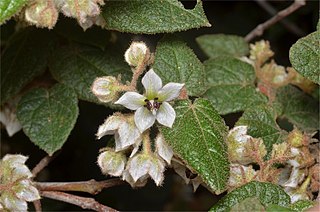
Lasiopetalum schulzenii, commonly known as drooping velvet-bush, is a species of flowering plant in the family Malvaceae and is endemic to southern continental Australia. It is a shrub with heart-shaped leaves and small groups of hairy white and reddish-brown flowers.

Lasiopetalum baueri, commonly known as slender velvet bush, is a species of flowering plant in the family Malvaceae and is endemic to south-eastern Australia. It is a small, greyish shrub with more or less linear to narrowly oblong or narrowly elliptic leaves and groups of white or pink flowers.

Pultenaea densifolia, commonly known as dense-leaved bush-pea, is a species of flowering plant in the family Fabaceae and is endemic to southern continental Australia. It is a spreading or low-lying shrub with broadly egg-shaped, down-curved leaves and clusters of purple or yellow, red and purple flowers.
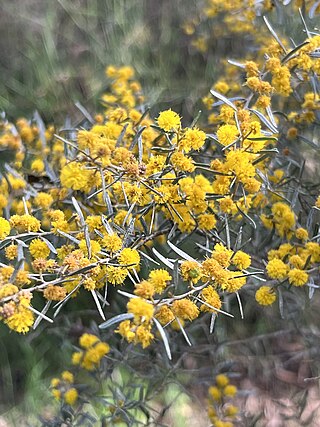
Acacia wilhelmiana, commonly known as dwarf nealie, Wilhelmi’s wattle and mist wattle, is a shrub belonging to the genus Acacia and the subgenus Plurinerves native to the mallee region of central and eastern Australia.
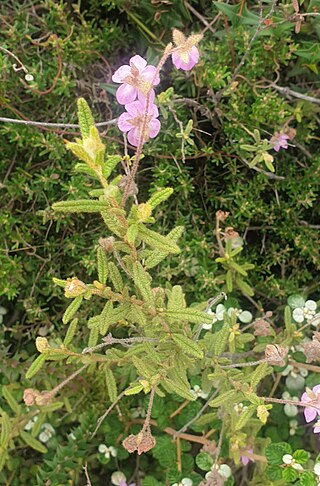
Thomasia petalocalyx, commonly known as paper flower, is a species of flowering plant in the family Malvaceae and is endemic to southern Australia. It is a shrub with wrinkled, oblong to egg-shaped leaves and cup-shaped mauve flowers.

Commersonia craurophylla, commonly known as brittle leaved rulingia, is a species of flowering plant in the family Malvaceae and endemic to southern continental Australia. It is a dense, spreading shrub with crinkled, narrowly oblong to linear leaves, and white to cream-coloured flowers.

Pultenaea canaliculata, commonly known as coast bush-pea, is a species of flowering plant in the family Fabaceae and is endemic to coastal areas of southern continental Australia. It is an rigid, spreading shrub with hairy, cylindrical leaves, and yellow and crimson flowers.

Pultenaea subalpina, commonly known as rosy bush-pea, is a species of flowering plant in the family Fabaceae and is endemic to a restricted area of Victoria. It is a rigid, prostrate to erect or spreading shrub with linear leaves and pink, pea-like flowers.
Lasiopetalum compactum, is a species of flowering plant in the family Malvaceae and is endemic to the south-west of Western Australia. It is an erect shrub with leathery, narrowly oblong leaves and cymes of white to pinkish flowers.
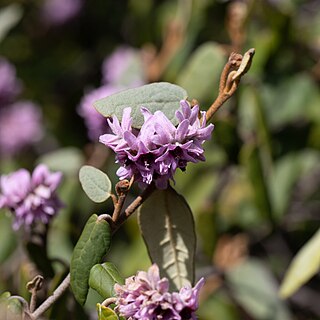
Lasiopetalum discolor, commonly known as coast velvet-bush, is a species of flowering plant in the family Malvaceae and is endemic to coastal areas of southern Australia. It is an erect, spreading or sprawling shrub with hairy stems, oblong to egg-shaped leaves and pink or white flowers.

Lasiopetalum drummondii is a species of flowering plant in the family Malvaceae and is endemic to the south-west of Western Australia. It is an erect, slender shrub with many densely hairy stems, egg-shaped or oblong leaves and white, pink and red flowers.
Lasiopetalum ferraricollinum is a species of flowering plant in the family Malvaceae and is endemic to the south-west of Western Australia. It is an upright shrub with densely hairy stems, narrow egg-shaped to oblong leaves and white to cream-coloured and dark red flowers.

Lasiopetalum molle, commonly known as soft leaved lasiopetalum, is a species of flowering plant in the family Malvaceae and is endemic to the south-west of Western Australia. It is an erect or spreading subshrub or shrub with hairy stems, thick and stiff egg-shaped leaves and pink flowers.
Lasiopetalum monticola is a species of flowering plant in the family Malvaceae and is endemic to the south-west of Western Australia. It is an erect, slender or straggling shrub with densely hairy branchlets, leaves and flowers, egg-shaped leaves and pink, cream-coloured or white flowers.

Lasiopetalum oldfieldii is a species of flowering plant in the family Malvaceae and is endemic to the south-west of Western Australia. It is a low, spreading shrub with rusty-hairy young stems, egg-shaped to narrowly egg-shaped leaves and pink and dark red flowers.

Lasiopetalum parvuliflorum is a species of flowering plant in the family Malvaceae and is endemic to the south-west of Western Australia. It is an erect, spreading shrub with hairy stems, oblong to linear leaves and green or cream-coloured flowers.
Lasiopetalum × tepperi is a species of flowering plant in the family Malvaceae and is endemic to the south-east of South Australia. It is an erect, spreading or sprawling shrub with hairy stems, egg-shaped to lance-shaped leaves and pink flowers.

Spyridium bifidum, commonly known as forked spyridium, is a species of flowering plant in the family Rhamnaceae and is endemic to South Australia. It is an erect shrub with densely softly-hairy young stems, wedge-shaped to linear leaves sometimes with a two-lobed tip, and densely woolly heads of white-velvety flowers.
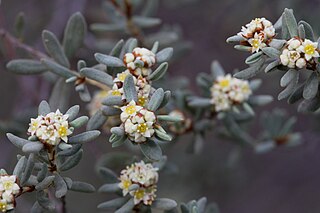
Spyridium subochreatum is a species of flowering plant in the family Rhamnaceae and is endemic to southern continental Australia. It is a low shrub with linear to oblong or narrowly egg-shaped leaves, and dense clusters of creamy-white flowers with dark brown, papery bracts at the base.
Thomasia × formosa is a species of flowering plant in the family Malvaceae and is endemic to a restricted area of the south-west of Western Australia. It is an erect, compact shrub with densely hairy branchlets, hairy, coarsely serrated, egg-shaped to elliptic or oblong leaves, and racemes of pink or purple flowers arranged in leaf axils.

















